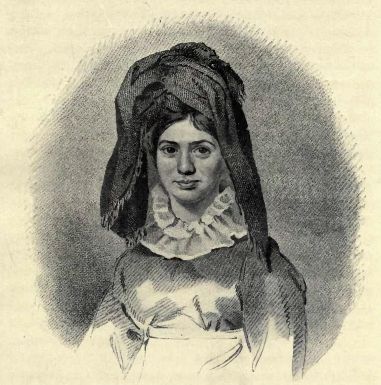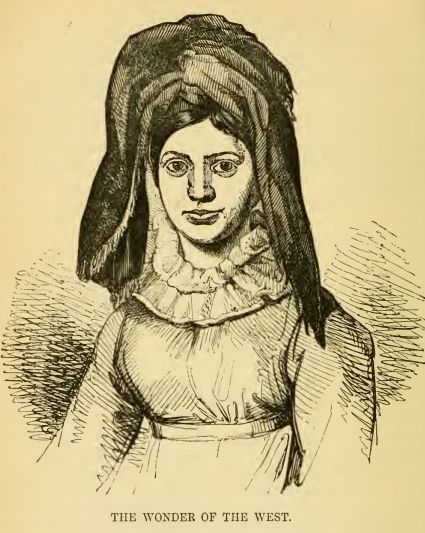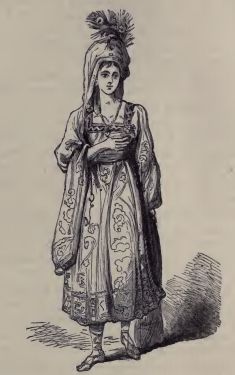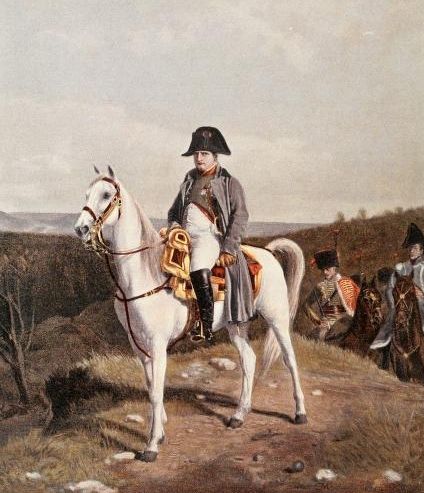nn
n
n On the afternoon of Thursday April 3rdn1817, the overseer of the parish of Almondsbury, Gloucestershire brought anyoung woman to Knole Park, the home of the local magistrate, Samuel Worall Esq.nShe had wandered into one of the cottages in the village but no one couldnunderstand a word she said. Worall had a Greek valet, who spoke severalnlanguages, but he couldn’t understand her either. She was slim, not exactlynpretty but there was intelligence in her dark eyes, she stood about five feetntwo inches tall, seemed about twenty-five years old, with black hair and neat,nwell-cared–for hands that seemed unaccustomed to hard work. She was dressednpoorly but quaintly, in a black muslin dress, shawl and a sort of turban, shenhad a few coins in a pocket, a small piece of soap wrapped in linen and worenworsted stockings and black leather shoes.
n
n
n
 |
| Princess Caraboo |
n
n
n
nMrs Worall arranged for her maid andna footman to take the stranger to the village inn, where she was to be givennfood and a clean bed, but when she was taken into the room she made to lie downnon the mat to sleep and had to be shown how to use the bed. Early on the nextnmorning, Mrs Worall went to the inn and found the girl staring dejectedly intonthe fire but when she was shown some picture books, she became very excited in illustrationsnon China and the Chinese. Through pointing and repetition, Mrs Worall was madento understand that the girl’s name was Caraboo.
n
n
n
 |
| Princess Caraboo |
n
n
n
nShe was taken back to Knole andnthen to Bristol, where she was placed at St Peter’s Hospital but she refusednall food and would only drink water. Mrs Worall took her back to Knole andneventually a gentleman who had travelled in the East managed to make some smallncommunication with Caraboo. She was the daughter of a high-ranking Chinesenfather and a Malay mother, and had been kidnapped by a pirate called Chee-ming,nwho had sold her to the captain of a brig called the Tappa-Boo, who tooknher to Batavia where she was put on a ship to England, which was reached afterneleven weeks at sea.
n
n
n
nShe escaped from the abusive crew by jumping overboard andnswimming ashore, where she swapped her embroidered silk dress for the darknclothes she was found wearing in a cottage with green painted doors, but shendidn’t know where this was. She had wandered in England for six weeks beforenarriving at Almondsbury. Over the next ten weeks, more information wasnrevealed; she preferred to eat rice and vegetables and refused meat, other thanna bird which she killed and cooked herself, sprinkling its blood on the groundnand covering it with earth. She fasted on Tuesdays, when she would make her waynonto the roof and pray to the sun. She was never heard to utter a syllable thatneven slightly resembled a European word.
n
n
n
 |
| The Wonder of the West – Caraboo |
n
n
n
nAnd then, on June 6th, shendisappeared, taking nothing with her other than what she had been given. MrsnWorall eventually received word that Caraboo was in Bath, so she went therenimmediately and found her in the sitting room of a lady of high fashion,nattended by servants and dressed in silks and feathers. The Princess of Javasu,nas she was now called, returned again to Knole but the story of Caraboo hadnspread throughout the West of England.
n
n
n
nDuring the following week, a Mrs Nealensent word to Knole, claiming that the Princess had lodged with her at Bristol,nand a wheel-wright’s son from Westbury arrived with the tale that he had seennCaraboo sitting at the roadside to Almondsbury, when a gentleman had taken pitynon her and treated her to beefsteaks and rum and hot water in an inn. MrsnWorall took Caraboo to Bristol, on the pretence that she would have a portraitnpainted, but instead went to Mrs Neale and her daughter, who told her that theynknew the Princess very well. When faced with the evidence, Caraboo broke downnand the true story was revealed.
n
n
n
 |
| The Princess of Javasu |
n
n
n
nHer name was Mary Baker, she had been born inn1791 at Witheridge, Dorsetshire, to poor parents, and she had spent her earlynsummers weeding the cornfields and her early winters spinning wool. At sixteen,nshe went as a servant to a Mr Moon and stayed for two years, leaving when hernrequest that her wages should be raised from ten pence to one shilling a weeknwas refused. She ran away and made her way via Exeter, Bristol and Taunton tonLondon, where she begged from door to door. She fell ill and was sent to StnGiles Hospital, where a dissenting clergyman took pity on her and found her anposition with Mrs Matthews, a strict Calvinist lady, who taught Mary to read.
n
n
n
nShe stayed with Mrs Matthews for three years but following an argument aboutnher behaviour, Mary ran away again and resolved to return to Devon, and spentnyears drifting with a variety of low-life characters. She married a sailor innLondon, and went with him to Brighton and Dover until she became pregnant, whennhe ran away and left her. The child was placed in the Foundlings’ Institutionnand Mary took a servant’s job nearby, visiting it every week until it died,nwhereupon she took up with a band of gypsies, telling fortunes, and eventuallynmaking her way back to Witheridge.
n
n
n
 |
| Caraboo – A Narrative of a Singular Imposition – 1817 |
n
n
n
nMary Baker may have been an impostor but shenhadn’t really done anything wrong – she never asked for anything, she did notnsteal anything, she didn’t take anything that wasn’t freely given. Her solenmotivation, it appeared, was simply to be Caraboo. Her fame spread – thenEarl of Cork and the Marquess of Salisbury had interviews with her, hearing hernstory and getting her to speak her ‘lingo’ and, undoubtedly, pressing a coin orntwo into her hand. A parody of the stanzas about Lochinvar (from Scott’snMarmion) was circulated, the first verse reading,
n
n
n
n“Oh ! young Caraboonis come out of theWest,n
nIn Frenchified tatters the damsel is drest;n
nAnd, savenone pair of worsted, she stockings had none,n
nShe tramped half unshod, and shenwalked all alone:n
nBut how to bamboozle the doxy well knew;n
nYou ne’er heard ofngypsey like young Caraboo.”n
n
n
nMuch sport was had in the popular press on thengullibility of the rural middle classes. Eventually it was decided that shenwould emigrate to America, and with Mrs Worall’s help she booked passage in thenname of Burgess, her mother’s maiden name, on the Robert and Anne out ofnBristol bound for Philadelphia. In 1824, Princess Caraboo was back in Londonnand if you paid a shilling, you could visit her on New Bond Street, althoughnthe novelty had worn thin by then and there were few subscribers. She was laternsaid to have made a living selling medicinal leeches to the Bristol Infirmary,nto have remarried and borne a daughter, before she died in her seventies andnwas buried in an unmarked grave.
n
n
n
 |
| Napoleon Bonaparte |
n
n
n
nThere is an unsubstantiated rumour that whennthe Robert and Anne was sailing across the Atlantic Ocean, a stormnforced it off course and so far south that it was close to the island of StnHelena. Princess Caraboo took a boat and rowed herself ashore, where she metnNapoleon Bonaparte, who was imprisoned there by the British following hisndefeat at the Battle of Waterloo. It is said that the exiled Emperor was sontaken by the Princess of Javasu that he offered to divorce Maria Louisa andnmarry her instead.
nnn
n
nnnn


















